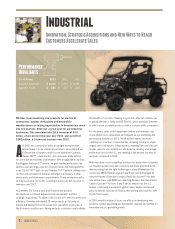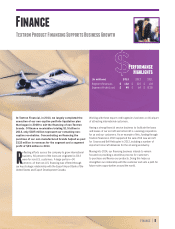E-Z-GO 2013 Annual Report Download - page 19
Download and view the complete annual report
Please find page 19 of the 2013 E-Z-GO annual report below. You can navigate through the pages in the report by either clicking on the pages listed below, or by using the keyword search tool below to find specific information within the annual report.
6Textron Inc. Annual Report • 2013
Backlog
Our backlog at the end of 2013 and 2012 is summarized below:
(In millions)
December 28,
2013
December 29,
2012
U.S. Government:
Bell $ 5,509 $ 6,382
Textron Systems 1,905 2,037
Total U.S. Government backlog 7,414 8,419
Commercial:
Bell 941 1,087
Cessna 1,018 1,062
Textron Systems 898 882
Industrial 2 13
Total commercial backlog 2,859 3,044
Total $ 10,273 $ 11,463
Approximately 43% of our total backlog at December 28, 2013 represents orders that are not expected to be filled in 2014. Orders
from Cessna customers, which cover a wide spectrum of industries and individuals worldwide, are included in backlog when the
customer enters into a definitive purchase agreement and the initial customer deposit is received. We work with our customers to
provide estimated delivery dates, which may be adjusted based on customer needs or our production schedule, but do not establish
definitive delivery dates until approximately six months before expected delivery. There is considerable uncertainty as to when or
whether backlog will convert to revenues as the conversion depends on production capacity, customer needs and credit
availability; these factors also may be impacted by the economy and public perceptions of private corporate jet usage. While
backlog is an indicator of future revenues, we cannot reasonably estimate the year each order in backlog ultimately will result in
revenues and cash flows. Orders remain in backlog until the aircraft is delivered or upon cancellation by the customer. Upon
cancellation, deposits are used to defray costs, including remarketing fees, cost to reconfigure the aircraft and other costs incurred
as a result of the cancellation. Remaining deposits, if any, may be retained or refunded at our discretion.
Backlog with the U.S. Government in the above table includes only funded amounts as the U.S. Government is obligated only up
to the amount of funding formally appropriated for a contract. Bell’s backlog includes $2.7 billion related to a multi-year
procurement contract with the U.S. Government for the purchase of V-22 tiltrotor aircraft.
U.S. Government Contracts
In 2013, approximately 30% of our consolidated revenues were generated by or resulted from contracts with the U.S. Government.
This business is subject to competition, changes in procurement policies and regulations, the continuing availability of funding,
which is dependent upon congressional appropriations, national and international priorities for defense spending, world events, and
the size and timing of programs in which we may participate.
Our contracts with the U.S. Government generally may be terminated by the U.S. Government for convenience or if we default in
whole or in part by failing to perform under the terms of the applicable contract. If the U.S. Government terminates a contract for
convenience, we normally will be entitled to payment for the cost of contract work performed before the effective date of
termination, including, if applicable, reasonable profit on such work, as well as reasonable termination costs. If, however, the U.S.
Government terminates a contract for default, generally: (a) we will be paid the contract price for completed supplies delivered and
accepted and services rendered, an agreed-upon amount for manufacturing materials delivered and accepted and for the protection
and preservation of property, and an amount for partially completed products accepted by the U.S. Government; (b) the U.S.
Government may not be liable for our costs with respect to unaccepted items and may be entitled to repayment of advance
payments and progress payments related to the terminated portions of the contract; (c) the U.S. Government may not be liable for
assets we own and utilize to provide services under the “fee-for-service” contracts; and (d) we may be liable for excess costs
incurred by the U.S. Government in procuring undelivered items from another source.
Research and Development
Information regarding our research and development expenditures is contained in Note 1 to the Consolidated Financial Statements
on page 53 of this Annual Report on Form 10-K.
























